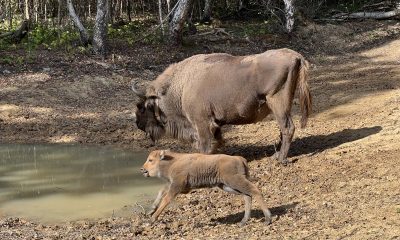Antarctica lost more than 3,000 billion tons of ice over 25 years
The ice would equal 137 Empire State Buildings placed on top of one another.
Published
1 year ago onBy
Talker News
By Chris Dyer via SWNS
Antarctica has lost more than 3,000 billion tons of ice over 25 years - enough to cover London at seven times the height of the Shard.
Since 1996 the Amundsen Sea Embayment has lost so much Antarctic sheet ice that if it was piled on London, it would stand over 2km tall - or 7.4 times the height of the Shard, which is the second tallest building in Europe.
If the lost ice was covered over the area of Manhattan, it would stand at 61km – or 137 Empire State Buildings placed on top of one another.
As many as 20 major glaciers form the Amundsen Sea Embayment in West Antarctica, which is more than four times the size of the UK.
They play a key role in contributing to the level of the world’s oceans, scientists said.
So much water is held in the snow and ice that if it were to all to drain into the sea, global sea levels could increase by more than one meter, experts warned.
Researchers calculated the “mass balance” of the Amundsen Sea Embayment and looked at the balance between mass of snow and ice gain due to snowfall and mass lost through calving, where icebergs form at the end of a glacier and drift out to sea.
When calving happens faster than the ice is replaced by snowfall, then the Embayment loses mass overall and contributes to global sea level rise, scientists said.
And when snowfall supply drops, the Embayment can lose mass overall and contribute to sea level rise, according to researchers.
Scientists discovered that West Antarctica saw a net decline of 3,331 billion tons of ice between 1996 and 2021, contributing over nine millimeters to global sea levels.
Changes in ocean temperature and currents are thought to have been the most important factors driving the loss of ice, experts said.
Dr. Benjamin Davison, a research Fellow at the Institute for Climate and Atmospheric Science at University of Leeds, said: “The 20 glaciers in West Antarctica have lost an awful lot of ice over the last quarter of a century.
"And there is no sign that the process is going to reverse anytime soon although there were periods where the rate of mass loss did ease slightly.
“Scientists are monitoring what is happening in the Amundsen Sea Embayment because of the crucial role it plays in sea-level rise.
"If ocean levels were to rise significantly in future years, there are communities around the world who would experience extreme flooding.”
Using climate models that showed how air currents move around the world, the scientists identified that the Amundsen Sea Embayment suffered several extreme snowfalls over the 25-year period the scientists examined.
These would have resulted in periods of heavy snowfall and periods of very little snowfall or a “snow drought,” the team found.
Researchers factored these extreme events into their calculations and found these contributed up to half of the ice change at certain times.

Therefore the snowfalls played a key role in the contribution the Amundsen Sea Embayment was making to sea level rise during certain time periods, scientists said.
For example, between 2009 and 2013, the models revealed a period of persistently low snowfall, or “snow drought,” the researchers discovered.
Dr. Davison added: “Changes in ocean temperature and circulation appear to be driving the long-term, large-scale changes in West Antarctica ice sheet mass.
“We absolutely need to research those more because they are likely to control the overall sea level contribution from West Antarctica.
“However, we were really surprised to see just how much periods of extremely low or high snowfall could affect the ice sheet over two to five-year periods – so much so that we think they could play an important, albeit secondary role, in controlling rates of West Antarctic ice loss.”
The lack of "nourishing" snowfall starved the ice sheet and caused it to lose ice, therefore contributing about 25 percent more to sea level rise than in years of average snowfall, it was found.
In contrast, during the winters of 2019 and 2020 there was very heavy snowfall, according to the study results.
Scientists estimated this heavy snowfall mitigated the sea level contribution from the Amundsen Sea Embayment, reducing it to about half of what it would have been in an average year.
Dr. Pierre Dutrieux, a scientist at the British Antarctic Survey and co-author of the study, added: “Ocean temperature changes and glacial dynamics appear strongly connected in this part of the world, but this work highlights the large variability and unexpected processes by which snowfall also plays a direct role in modulating glacier mass. “
Ice loss from the region over the past 25 years has seen the retreat of the Pine Island Glacier, also known as PIG.
As it retreated, one of its tributary glaciers became detached from the main glacier and rapidly accelerated.
As a result, the tributary glacier has now been named by the UK Antarctic Place-names Committee, Piglet Glacier, so that it can be unambiguously located and identified by future studies, the researchers said.
Co-author Professor Anna Hogg, of the Institute of Climate and Atmospheric Science , said: “As well as shedding new light on the role of extreme snowfall variability on ice sheet mass changes, this research also provides new estimates of how quickly this important region of Antarctica is contributing to sea level rise.
“Satellite observations have shown that the newly named Piglet Glacier accelerated its ice speed by 40 percent, as the larger PIG retreated to its smallest extent since records began.”
Satellites such as the European Space Agency's Copernicus Sentinel-1 satellite, which uses sensors that ‘see’ through clouds even during the long Polar night, have transformed the ability of scientists to monitor remote regions and to monitor the incredibly rapid change taking place in Antarctica, the experts added.
The research was published in the journal Nature Communications.
Stories and infographics by ‘Talker Research’ are available to download & ready to use. Stories and videos by ‘Talker News’ are managed by SWNS. To license content for editorial or commercial use and to see the full scope of SWNS content, please email [email protected] or submit an inquiry via our contact form.
You may like


Scientists warn light pollution endangers glow-worm populations


Astronomers find place with two suns just like Tatooine in Star Wars


Why special bridges are being built for wild bison


How amputees could feel temperature with their prosthetics


New clean fuel could bring cars powered by sunshine


Simple blood test could predict if patients likely to develop PTSD
Other Stories


Blood test can detect signs of knee condition 8 years before X-rays
Early detection could lead to treatments that slow the progression of the most common form of arthritis.


Man captures ultra rare albino squirrel on camera
The white squirrel has red eyes so is thought to be an albino squirrel.


Adorable dog kicks his leg while he walks
A video captured the pup bouncing along the street of his native China.


Woman with rare ‘Sleeping Beauty’ condition sleeps every four hours
She was diagnosed at age 18 after years of struggling to stay awake in school and nodding off during class.


97-year-old veteran receives WWII service medal 80 years later
"We’re all so proud of Eve."
Top Talkers

 Parenting1 week ago
Parenting1 week agoSingle mom details struggles of feeding her 12 kids

 Lifestyle1 week ago
Lifestyle1 week agoWoman regrets her tattoo nightmare: ‘It’s horrendous’

 Wildlife4 days ago
Wildlife4 days agoClever elephant returns visitor’s shoe that fell into enclosure

 Health5 days ago
Health5 days agoNew study reveals ‘old age’ begins later than it used to

 Good News5 days ago
Good News5 days agoDisabled student takes first steps in 10 years on graduation stage

 Animals14 hours ago
Animals14 hours agoAdorable dog kicks his leg while he walks

 Entertainment2 days ago
Entertainment2 days agoWhat is the perfect movie length?

 Broadcast20 hours ago
Broadcast20 hours agoAre allergies interfering with your social life?
